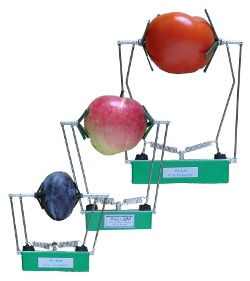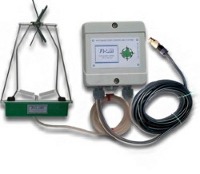- PTM-48A Photosynthesis Monitor
- PM-11 Phytomonitor
- Sensors for PTM-48A and PM-11
- Overview
- Plant Sensors
- Environmental Sensors
- Sensors for third party loggers
- Overview
- Plant Sensors
- Environmental Sensors

30 to 160 mm
15 to 90 mm
7 to 45 mm

FI-LP (30 to 160 mm) FI-MP (15 to 90 mm) FI-SP (7 to 45 mm) Fruit Growth sensors
Overview
A series of absolute displacement sensors provides recording both size and growth rate of intact rounded fruits in three diameter ranges within 7 to 160 mm. Two phenomena affect fruit diameter. These are growth and internal water content. The growth component is usually dominant. At the same time, in some cases, the fruit may loose water that is manifested in deceleration of growth rate or even shrinkage of the fruit. It may be a result of water stress, lack of light, or another limiting factor. Thus, the FI-type sensor allows investigating effect of irrigation rate and other environmental factors on both water balance and growth of fruits. Another exiting application of the sensor is monitoring of harvested fruits during storage.
The FI-type sensor consists of an LVDT transducer mounted in a special clip and a DC powered signal conditioner.
The probe is connected by a standard 1-meter cable to the waterproof box with the signal conditioner inside.
Standard output cable length between signal conditioner and monitor is 4 meters.
Original parallelogram design of moving arms provides firm and straight positioning of the sensor's flaps on a fruit under study.
FI-LP (large), FI-MP (medium) and FI-SP (small) models have different clips for providing three measurement ranges: 30 to 160, 15 to 90 and 7 to 45 mm, respectively.
Specifications
| FI-LP | FI-MP | FI-SP | |
| Measurement range | 30 to 160 mm | 15 to 90 mm | 7 to 45 mm |
| Resolution, mm | 0.065 | 0.038 | 0.019 |
| Operating temperature | 0 to 50 ℃ | ||
| Temperature effect | < 0.02% total stroke/℃ | ||
| Signal conditioner Protection index | IP 64 | ||
| Cable length between probe and signal conditioner | 1 m | ||
| Output cable length | 4 m | ||